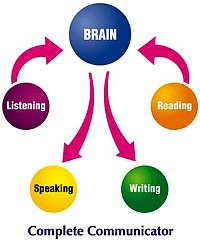 |
Learn English Locally, Apply It Worldwide! Enjoy Regular Practice |
The Present Continuous Tense
The Present Continuous tense is a verb construction that conveys a sense of ongoing action at the present time. This means that the action has started before the moment of speaking and it will finish at an indefinite moment after the present time.
I am reading "Pride and Prejudice" for the second time these days.
He is talking to his boss, so he can't come to the phone right now.
She is playing a piece from the "Swan Lake" by Tchaikovsky.
Formulation of the Present Continuous tense
To build this tense we need to use the auxiliary verb 'to be' in the present tense plus the present participle (the -ing form) of the main verb:
- I am speaking
- You are speaking
- He/She/It is speaking
- We are speaking
- You are speaking
- They are speaking
Usage of the Present Continuous tense
- To refer to events that are in progress or are true at the time of speaking or writing;
- To describe actions that are repeated or regular but are judged to be temporary;
- To describe regular actions in relation to a particular time or a specified event, especially when those events interrupt something already in progress;
- To refer to gradual processes of change
- With adverbs of indefinite frequency (such as always, constantly, continually, forever) to describe events that are regular but unplanned and often undesired.
Confusion between the Present Simple and the Present Continuous Tenses
In some instances we need to use a form of the present tense to show
that something is happening now and is continuing to happen. This tense
is the Present Progressive or Continuous.
Native English speakers do not have any trouble deciding which form of the present tense to use, but this is an endless source of difficulty to foreigners. Try your hand by doing this exercise.
Action Verbs vs. State Verbs
The majority of the verbs are action verbs, designating an action that one can start and end as and when one wants to: come, go, play, talk, wait, write, read, speak, etc.
On the contrary, state verbs designate a mental state, that one can not start and stop whenever one wants to. There is a sense of continuity in them: exist, be, have, know, believe, understand, etc. Because of this implied natural continuity, these verbs do not take the Present Continuous tense.
Examples of verbs that are not normally used in the continuous aspect:
- Verbs of perception: see, hear, notice, smell, taste, feel, etc.
- Verbs of thinking: think (that), consider (that), understand, know, realise, suppose, believe, remember, forget, recollect, recall, expect, mind, etc.
- Verbs of feeling: want, wish, desire, like, hate, dislike, care, refuse, forgive, mind, adore, hope, intend, agree, etc.
- Verbs indicating states of permanent qualities of people or objects: be, belong, own, have (=possess), contain, include, comprise, weigh, measure, cost, resemble, consist, require, need, etc.
- Miscellaneous verbs: concern, matter, mean, seem, signify, appear (=seem), keep (=continue), etc.
English Corner Weekly E-zine
Packed with knowledge, published on Tuesdays.
Get yours here!
Our Archives:
Our lessons in the names and sounds of letters, short & long vowel sounds, CVCs, CCVCs, CVCCs, sight words, vowel and consonant contrasts, etc.
Our lessons will help increase your vocabulary, word recognition, find meaning in context, skills for TOEFL tests and other games, for fun.
Here we shall build some lessons to help you improve your writing skills.
Lots of lessons: cause & effect, comparisons, linking signals, relative clauses, presenting information, expressing emotions and grammar games, of course. We had more lessons on: intensifying adverbs and phrasal verbs, expressing various concepts such as addition, exception, restriction and ambiguity. Lately we started some exercises: likes/dislikes, frequency adverbs (twice), verb tenses, etc.
Learn how to build a website, by using the SBI! system - start from the basics, developing a site concept and a niche, supply and demand, learn about profitability and monetization, payment processing, register domain, website structure and content as a pyramid. Also learn about the tools I'm using to build this website. We also covered how to build traffic, working with search engines, building a good system of inbound links, using social marketing and blogs with the SBI system, how to use Socialize It and Form Build It, how to publish an e-zine and how to build a social network in your niche.
We looked at a few games by now: Countable & uncountable nouns, Free Rice, Name That Thing, Spell It, Spelloween, the Phrasal Verbs Game, Preposition Desert, The Sentence Game, Word Confusion, Word Wangling, Buzzing Bees, and The Verb Viper Game.
Be prepared to play and learn more pretty soon.
